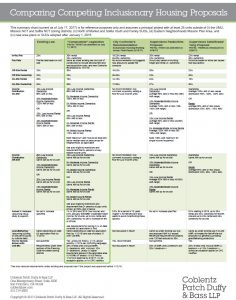 Is the City another step closer to sorting out inclusionary housing requirements and implementation of Proposition C? Board of Supervisors members have introduced two competing ordinances that seek to call the question regarding the City’s inclusionary housing priorities and requirements.
Is the City another step closer to sorting out inclusionary housing requirements and implementation of Proposition C? Board of Supervisors members have introduced two competing ordinances that seek to call the question regarding the City’s inclusionary housing priorities and requirements.
Very generally, the legislation introduced by Supervisors Safai, Breed and Tang comes closer to reflecting the City Controller’s recommendations regarding inclusionary housing percentages, summarized in our February blog post. It would also substantially increase the percentage of inclusionary units that are targeted for middle-income earners. By contrast, the legislation proposed by Supervisors Peskin and Kim would maintain inclusionary housing percentages and income level distributions that are closer to existing requirements.
As shown in our side by side summary chart, both ordinances would add new complexity to inclusionary housing requirements. For example, they would:
- Distinguish between requirements for ownership and rental units;
- Require rental units to remain rental for at least 30 years or meet higher requirements;
- Change income level distribution requirements;
- Revise the basis for the fee rate calculation; and
- Introduce new unit mix requirements, with an emphasis on larger, family-focused units.
Notably, the Safai/Breed/Tang legislation would apply the new unit mix requirements project-wide — not just to the inclusionary housing units — with certain exceptions.
The Peskin/Kim legislation would generally retain existing grandfathering protections for pipeline projects, and projects over 120 feet in height would generally be subject to a 30% requirement for off-site or fee compliance, as compared to the existing 33% requirement. The Safai/Breed/Tang legislation would generally retain existing grandfathering protections for pipeline projects complying with the on-site option but would generally eliminate such protections for off-site and fee compliance, although the proposed percentages are generally equivalent to or lower than existing grandfathering protections. There is an exception: existing protections for projects with an Environmental Evaluation (EE) application on file prior to January 1, 2013 would be retained in all instances.
One key issue is how inclusionary housing requirements should interact with State Density Bonus law. The Safai/Breed/Tang legislation would require that an “in-lieu” inclusionary housing fee be paid for any density bonus units, as recommended by the City Controller. As we previously reported, that requirement would be additive, meaning that millions of dollars of additional fees could be due for market rate housing projects with otherwise required inclusionary housing units provided on-site. The Peskin/Kim legislation does not currently specify that the fee would apply to density bonus units, but it proposes to increase the on-site inclusionary percentage by 5% for buildings over 300 feet — even though the City Controller reported that he found no evidence to support a higher requirement for high-rise projects.
The legislation is currently on hold under the Board’s 30 day rule, and is expected to be debated at the Land Use and Transportation Committee in the coming months. In the meantime, the Planning Commission is scheduled to hold an informational hearing on the legislation on March 16, 2017. Planning Department staff has produced a detailed analysis of the legislation, including exhibits that detail how the ordinances would impact fees and inclusionary percentages.



